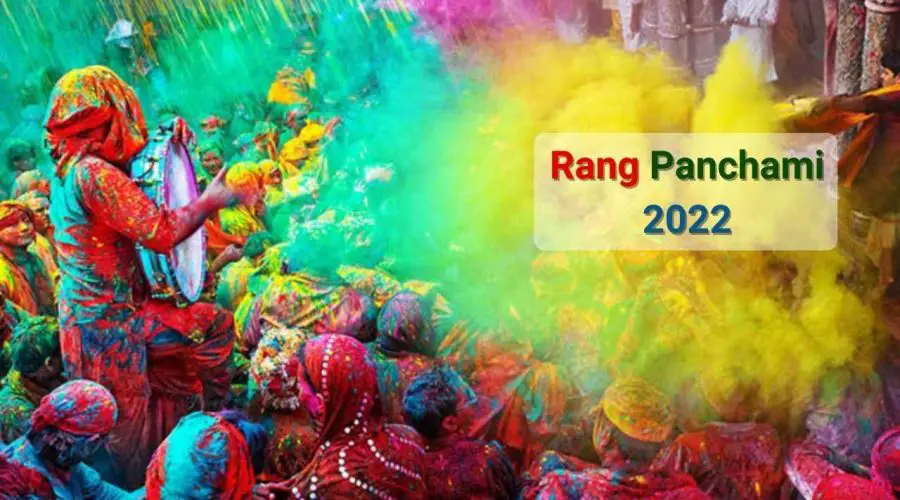Rang Panchami 2022: Date, Time, Celebration, and Significance
Article Rating
☆☆☆☆☆ 3.7/5
Holi is celebrated on Rang Panchami in several parts of India. In the rest of India, Rang Panchami falls after five days of Holi celebrations. Even in some temples in Madhya Pradesh’s Indore and Bhopal, Rang Panchami marks the end of the Holi celebrations. In Bhopal, Panchami is celebrated with the same zeal as Holi. In Bhopal, a procession is held in which people play with colours in a similar way to Holi.
Because the word ‘Rang’ means ‘colour’ and ‘Panchami’ means ‘fifth day,’ it is understood to be celebrated only after the Holi festival’s fifth day. You’re probably wondering what Rang Panchami is all about right now. It is similar to Holi in that it is marked by the throwing of Gulal and the spraying of coloured water on participants.
Rang Panchami 2022 Date
Tuesday, 22 March – Wednesday, 23 Mrach
Tithi – Chaitra Krishna Paksha Panchami
In Indian states such as Maharashtra, Bihar, Uttar Pradesh, Madhya Pradesh, and other regions of Northern India, it is regarded as one of the most important celebrations. This celebration would take place on the fifth day of the Krishna Paksha, the waning phase of the moon during the Hindu month of Phalguna, according to the Hindu and Gregorian calendars.
Rang Panchami Celebrations
Many people confuse Rang Panchami with Holi, despite the fact that they are both celebrated for different reasons. Let’s look at the many types of celebrations.
- A procession led by a water tank with a high-pressure jet, two ceremonial cannons, and a camel circumambulates the town in this event, which is primarily held in Indore and Maharashtra.
- Everyone on the street is coloured by it. Thousands of people assemble in front of Rajwada, especially in Indore, to be coloured by the canon. The heightened sensations of these ecstatic groups are amplified by bhang and booze.
- Holi is also known as Shimga or Shimgo among Maharashtrians.
- The festival is very popular with fishermen. They celebrate it on a grand scale and take part in the celebrations by singing, dancing, and making merry. These unique dances allow them to express all of their suppressed emotions, needs, and desires.
- People also make a strange sound with their mouths by striking their mouths with the backs of their hands.
- On this day, Hindu worshippers in some regions also worship Lord Krishna and Radha. They execute puja ceremonies to pay reverence to Krishna and Radha’s heavenly union. This festival is also thought to help individuals fall in love and stay in love.
- The most captivating aspect of the Rang Panchami celebrations is said to be a traditional Palkhi dance, which is performed by fishing tribes and communities in practically every corner of the country.
- The joy of Rang Panchami may be seen at the temples of Bihar, Vrindavan, Delhi, and Mathura. Playing colours, eating sweetmeats, meeting relatives, dancing to regional tunes, and so on are all part of the magnificence.
- Holi is celebrated with vigour and zeal by tourists and enthusiasts all throughout the country, with different rites and customs.
Significance of Rang Panchami
Rang Panchami is a Hindu festival with deep religious importance and is regarded as a significant ceremony. As we all know, Holika Dahan — the puja that takes place a day before Holi – is associated with a massive fire. The fire that is ignited during Holi purifies the atmosphere of all rajasic and tamasic particles. It emits a pure aura and fills the air with enormous positivity, assisting in the activation of numerous Deities in the form of colours. As a result, Rang Panchami is a festival commemorating the joy of purification.
As a result, Rang Panchami is a sign of victory over Rajas and Tamas, and it honours the ‘Panch Tatva,’ which is responsible for the creation of the universe (earth, light, water, sky, and wind). The human body is thought to be made up of five elements as well. Rang Panchami is a Hindu festival that celebrates the five essential components that serve to restore balance in life. Rang Panchami is inherently a symbol of victory over raja-tama and an appeal to the gods. On the day of Rang Panchami, a specific set of ceremonial ceremonies are performed to honour the incarnated forms of god-heads.
Frequently Asked Questions
1. What should we do on Rang Panchami?
People sprinkle fragrant red powder (gulal) and splash coloured water, among other things, on each other to celebrate. It is observed in conjunction with Holi, which occurs five days prior. Rangpanchami ceremonies use Dulendi instead of traditional colours.
2. Why do we celebrate Rang Panchami?
Madhya Pradesh, Maharashtra, and Uttar Pradesh are all experiencing it. It is said that on the day of Rang Panchami, the divine powers overpower the negative forces. On this day, it is recommended that you offer special worship and darshan of Radharani in her shrine.
3. What is difference between Holi and Rang Panchami?
Holi is known as Shigma or Rang Panchami in Maharashtra. It is observed in conjunction with Holi, which occurs five days prior. Rangpanchami ceremonies use Dulendi instead of traditional colors. On this day, people savor a special state delicacy known as ‘Puran Poli.’
4.
What problems do you get after playing colours on Rang Panchami?
We may experience difficulties such as blindness, skin cancer, asthma, itching of the skin, permanent plugging of perspiration pores, and so on after playing colours on Rang Panchami. This is due to the fact that the colours used in rang panchami, particularly the red colour, are extremely harmful. It includes a significant amount of mercury.

